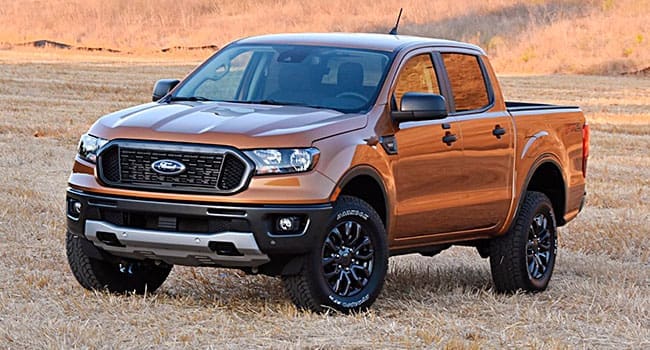
After a two-year absence, Ford has introduced its fourth-generation mid-size Ranger, hoping to fill the gap left by buyers who want a pickup truck but don’t need a full-size behemoth like the F-150
 Canadians love their pickup trucks. Out of the 10 top-selling vehicles in Canada, four are full-size pickup trucks: Chevrolet Silverado, GMC Sierra, Ram Truck and Ford F-150.
Canadians love their pickup trucks. Out of the 10 top-selling vehicles in Canada, four are full-size pickup trucks: Chevrolet Silverado, GMC Sierra, Ram Truck and Ford F-150.
And the F-150 has been the top-selling vehicle, period, in Canada for at least the last decade. It outsells perennial favourites like the Honda Civic and Hyundai Elantra year after year.
So Ford, after a two-year absence, has introduced its fourth-generation mid-size Ranger, hoping to fill the gap left by buyers who want a pickup truck but don’t need a full-size behemoth like the F-150.
The Ranger has an interesting history. Introduced in 1982, it was, for a time, co-built with Mazda and replaced the Courier model. It’s been sold around the world with various nameplates and badges, and built with a wide range of drive trains and trim levels.
These days, it’s available in three trim levels, including the Lariat FX4 EcoBoost.
Power is delivered by a 2.3-litre turbocharged four-cylinder engine that develops some 270 horsepower. It’s mated to a 10-speed automatic transmission, which has a tow/haul function and an auto stop/start feature, and you can drive it in either two-wheel or four-wheel drive. A centre console-mounted rotary dial allows you to choose from three driving modes: 4WD Low, 4WD High, and 2WD.
The Lariat model has a six-foot pickup bed and is offered with two cab styles: SuperCab and SuperCrew. My truck had the latter, which means seating for five adults but a slightly shorter cargo bed.
For a four-cylinder engine, the power plant in the Ranger feels much more powerful than its size would suggest. It has the bottom end grunt of a V6 and is responsive and lively, with all kinds of reserve power. Ford continues to excel at designing efficient and robust drive trains. I’m a little less happy with the 10-speed gearbox – it seems kind of random and erratic to me.
With such a pint-sized pickup bed, this is not intended to be a work truck (708 kg payload capacity). Sure, you can load it up and it has heavy-duty suspension, but it’s just not meant to carry a lot of stuff. More of a weekend warrior than down and dirty workhorse.
Suspension is rock hard and you feel every dimple and bump on the road. Not a problem if you like it that way but this truck is not a smoothie.
The stop/start function is a little annoying. Yes, it might save you some gas over the long run, but it’s kind of disruptive and you lose power steering momentarily when the vehicle is not running. I’d prefer this function was optional, thank you very much.
My truck had a small but nice little feature in the form of a sliding rear window. This provides added air circulation and, weather permitting, I just left it open.
With a starting price of just over $39,000 and a glitzy paint job, I’d think twice about putting this truck through its paces in the boonies. Ford is extolling the off-road virtues of the new Ranger but I’d be cautious if this was mine.
Fuel economy is 10.9 litres/100 km combined rating, which is pretty good, all things considered. By way of comparison, an F-150 consumes around 12.0 litres/100.
2020 Ford Ranger
Engine: 2.3-litre turbocharged four cylinder
Transmission: Ten-speed automatic
Drive: two-wheel/four-wheel
Horsepower: 270
Torque: 310 foot pounds
Base price: $39,407
Fuel economy: 11.8 litres/100 km (city) and 9.8 litres/100 km (highway), with regular gas
Some alternatives: Chevrolet Colorado. Honda Ridgeline, GMC Canyon, Nissan Frontier, Toyota Tacoma
Ted Laturnus writes for Troy Media’s Driver Seat Associate website. An automotive journalist since 1976, he has been named Canadian Automotive Journalist of the Year twice and is past-president of the Automotive Journalists Association of Canada (AJAC).
The views, opinions and positions expressed by columnists and contributors are the author’s alone. They do not inherently or expressly reflect the views, opinions and/or positions of our publication.

